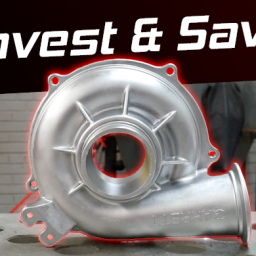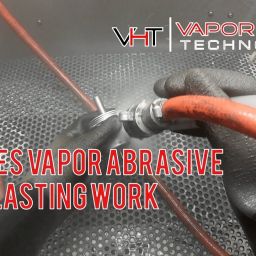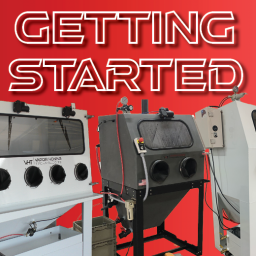Abrasive Blasting: An in-Depth Look at the Process and Output
The world first learned of the abrasive blasting process in 1870. Since Benjamin Chew Tilghman first patented it, abrasive blasting has gone through many changes—but it is still a common technique used by various mechanical industries.
What exactly is abrasive blasting? How and why is it used?
This guide will answer these questions and more. Secondly, it will cover everything you need to know about abrasive blasting, from the process to its uses and applications.
Last but not least, you might even find that abrasive blasting is the perfect technique you need to clean and finish your parts.
What Is Abrasive Blasting?
Generally speaking, abrasive blasting is the process of using highly-pressurized air or water to propel an abrasive material against a surface.
This process can remove corrosion, coatings, or surface contaminates. Other uses include altering the shape of an object and smoothing or roughening surfaces.
Full applications of abrasive blasting include:
- Smoothing rough surfaces
- Roughening smooth surfaces
- Shaping surfaces
- Removing contaminants, paints, or corrosion
- Cleaning or preparing surfaces
- Finishing surfaces
Abrasive blasting is most used on metal surfaces. Some examples include car or motorcycle engine parts, jewelry, or various types of cnc machined parts.
Most machinists, mechanics, or mechanical engineers will use abrasive blasting at some point in their career.
There are many different types of abrasive blasting. The distinctions between them depend on the kind of materials, machinery, or processes used.
The Abrasive Blasting Process
Almost all abrasive blasting systems contain three parts. These include:
- The abrasive container, or blasting pot
- The propelling device/mechanism
- The blasting nozzle
Compressed air or a centrifugally-powered wheel will work its way through each part to propel the media toward the blasted surface.
Some processes use water to form a slurry with the media, while others will shoot the abrasive media out dry.
Abrasive blasting machines come in many different forms.
Blast cabinets, or blast rooms, have the ability to reclaim and recycle blasted media for future use.
Wet Blasting vs. Dry Blasting
The two major categories of abrasive blasting is wet dry blasting. While there are many other sub-categories, all abrasive blasting will fall under the umbrella of one of these two types.
Just like the names suggest, the main difference here is water used in the abrasive propulsion process.
Wet blasting mixes water into the abrasive material to form a slurry that is then fired at the material surface. On the other hand, dry blasting uses pressurized air to propel dry materials at the blasted surface.
Wet Blasting Basics
Back in 1870, the world began using the earliest abrasive blasting techniques.
Most commonly used were wet blast cabinets. These cabinets formed a slurry of water and abrasive material used for surface finishing.
Wet blast cabinets are still commonly used today, though the technology has improved considerably in the last 150 years. You are no longer limited to cabinet blasting. Wet blast cabinet such as; the portable blast units, automatic machinery, and outdoor booths is modern wet blast system.
Wet blasting can utilize very fine or coarse abrasive media. Densities for materials can range from glass bead to steel, depending on what kind of surface you’re working with.
Wet blasting is particularly useful for de greasing and cleaning. This is because wet blasting uses soap and hot water in the abrasion process. It also helps that wet blasting does not leave any dust behind.
This process type is also prefer when you desire a more finely-tune surface profile. This is because the water acts almost like a cushion between the abrasive and the surface you’re working on.
Thus, wet blasting can decrease media breakdown rates while also cleaning and preventing foreign materials from sticking to the object surface.
Dry Blasting Basics
Dry blasting was developed later to incorporate a wider variety of abrasive materials. Generally, there are two types of dry blasting systems: siphon systems and direct pressure systems.
Siphon systems used compressed air to force abrasive materials through a nozzle or blasting gun. In addition, these systems can continuously operate for long periods, making them ideal for larger, more challenging jobs.
Direct pressure systems accelerate media from a pressure pot through the blast hose and eventually out the nozzle.
This creates a more efficient, quicker system than the siphon system. Direct pressure systems can also handle heavier media types.
The best time to use dry blasting is when you want to affect the surface. This is generally rougher, as the impact of the abrasive media is what changes your object surface.
It is also important to note that dry blasting will leave behind dust. This means a dust collector is generally require when dry blasting. It also means surfaces will not be immaculate once blasting is complete.
Abrasive Blasting Media Types
Whether you are using wet blasting or dry blasting, there are many abrasive blasting media types.
However, each type has its strengths and weaknesses. The kind you use will depend on the blasted surface type, and the blasting process’s intended result.
Some of the most commonly used media types include:
Glass Beads
Glass beads are a less aggressive abrasive blasting material which creates a softer, brighter finish on blasted surfaces. It is also easily recyclable.
Glass beads is better for buffing and polishing stainless steel applications.
Aluminum Oxide
Superiority rigid and robust, aluminum oxide is great for etching. This abrasive is great in preparation for paint or coated surface.
Aluminum oxide is a good option for almost all surface types, including aluminum, stainless steel, cast iron, and steel.
Plastics
Plastic abrasive media is generally made from crushed urea, polyester, or acrylics. Each plastic type comes in a range of different sizes and surface hardness.
Plastic is a good option for mold cleaning, blasting of plastic parts, or applications where the removal of underlying layers is not permitted. Automotive, marine, and electronic industries commonly use plastic media.
Silicon Carbide
The hardest blasting material available, silicon carbide, also superior choice for the toughest jobs. Challenging jobs are no match for the various sizes, colors, and forms silicon carbide can take.
Silicon carbide can be used on any surface material. Typical uses include glass etching, polishing, lapping, and general-purpose heavy-duty blast cutting operations.
Steel Shot and Grit
Steel shot is tough and recyclable. It is also highly cost-effective, making it a great alternative to more costly abrasive media types.
To be most effective, the proper size, hardness, and shape are essential to media selection.
Steel shot is also a great way to remove surface contaminants, texture a surface before coating, or preening (hardening) surfaces.
Walnut Shells
The hardest of the soft abrasives, walnut shells, come in a variety of sizes. Walnut shells are useful for polishing soft surfaces that harder abrasive materials could damage.
Walnut shells is a great way to polish soft metals, wood, fiberglass, plastic, and stone. It is also useful for the tumbling of gems and jewelry.
Corn Cobs
Corn cobs, made from finely ground corn cob pieces, are the softest available abrasive type. This abrasive is also an ideal way for cleaning, de-burring, burnishing, and de-flashing surfaces.
Corn cobs are commonly used to clean and polish jewelry, cutlery, engine parts, fiberglass, and debris or graffiti removal from wood, brick, or stone.
Other media types can be used when abrasive blasting. However, these are the general types that you will most often encounter. Most types are safe to use when wearing proper protective gears.
Types of Abrasive Blasting
You will likely hear abrasive blasting referred to by many different names. Generally, these terms refer to the type of media used, the blasting method, and/or the application.
Bead Blasting
Bead blasting uses glass beads, typically propelled at lower air pressure. You’ll find this type in both wet and dry blasting applications. Glass beads also do not contain silica, therefore, making them a safer blasting type.
Bead blasting leaves a bright, clean finish. This makes it particularly useful for removing paint, corrosion, or rust without leaving behind any embedded materials—the smaller the beads, the smoother the finish.
Shot Blasting
Shot blasting uses a spherical steel shot with a significant amount of pressure. It is used in both blast cabinets or blast rooms.
Steel shot is typically used to clean a metal surface and add compressive strength to any blasted surface.
Wheel Blasting
Wheel blasting uses shot, grit, or other heavier media types. The main distinction here is the centrifugally-powered wheel that is used as the abrasive propellant instead of compressed air or water.
This is best used for stronger surface types.
Soda Blasting
Soda blasting uses sodium bicarbonate and compressed air. Thus, is most often used for automotive restoration, wood cleaning, graffiti removal, rust removal, and boat hull cleaning.
Micro-Blasting, or Pencil Blasting
Micro-blasting is used for glass etching or other detailed applications. This is done by using specialized equipment that is specially made for small surfaces.
There are other blasting types that you may encounter, depending on machinery and abrasives used. However, these are the most common you’ll likely encounter and use in your surface finishing.
You can even test different application types to determine which one might be right for you.
Abrasive Blasting vs. Sandblasting
You’ve probably heard of sandblasting, but how is it different?
The terms sandblasting and abrasive blasting are relatively interchangeably. However, there are a few key differences you might not be aware of.
Sandblasting is the use of very fine abrasive materials. In most cases, actual sand won’t be used, as it contains silica. Silica inhalation can lead to serious health problems and should be avoided.
Because sandblasting uses the finest abrasives, it usually requires twice the abrasive material as traditional abrasive blasting. That can be pretty cost-inefficient for most companies or applications.
However, it can be useful for etching or fine detail work.
Abrasive blasting, on the other hand, is generally more cost-efficient. It is typically used to form edges, clean vulnerable materials, or create intricate shapes.
The application uses for traditional abrasive blasting are endless, while sandblasting is much more specialized.
It is important to note that both blasting types require measures for safe use. Always wear personal protective equipment when handling any blasting materials.
Benefits of Abrasive Blasting
There are many benefits to using abrasive blasting for your surface work. These include:
- Deep cleaning of irregular surfaces
- Satin finish on all surfaces
- Leave smooth edges on cut surfaces
- Removal of surface contaminants
- Prepares surfaces for coating and bonding
- Eliminates the need for toxic chemical use
Abrasive Blasting in Industry
Abrasive blasting is used in various industries for a variety of purposes. The most common industries where you’ll find abrasive blasting include:
- Marine (shipbuilding and hull cleaning)
- Automotive (repair and restoration of engines and bodies)
- Construction and contracting
- Welding
- Metal casting
- Metal finishing
- Foundry Work
- Concrete
- Painting
- Surface or powder coating
- Surface preparation
- Glasswork (decorating, etching, engraving)
- Monument engraving
Virtually any industry that needs heavy-duty surface cleaning, preparation, or etching and engraving will use abrasive blasting.
If you have a tough surface that needs prepping, cleaning, or forming, abrasive blasting is the best way to do it.
Abrasive Systems for Every Use
Abrasive blasting is a versatile and heavily-utilized tool for almost all machine professionals.
Choosing your system and abrasive media type depends entirely on your individual needs. But, whatever your needs, there’s an abrasive media system out there for you.
Contact our experts today to learn more about our abrasive blasting machines and equipment. We can help you find exactly the right system and materials for you.
You’ll never have to worry about rough and dirty surfaces again!








